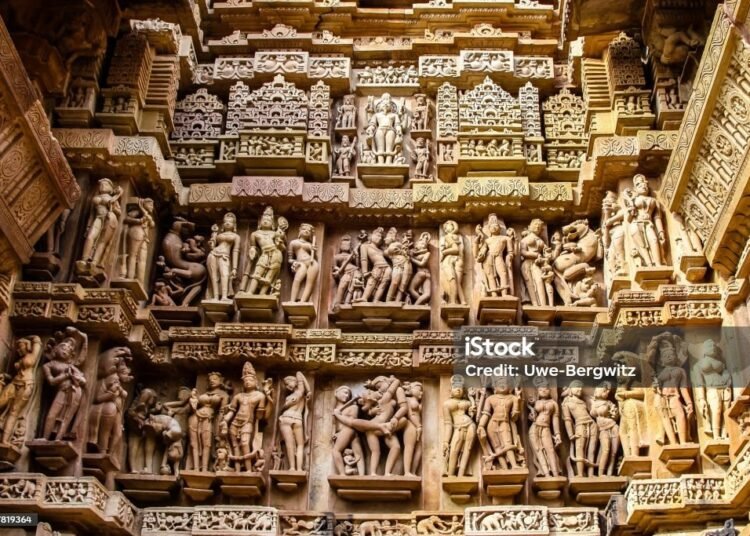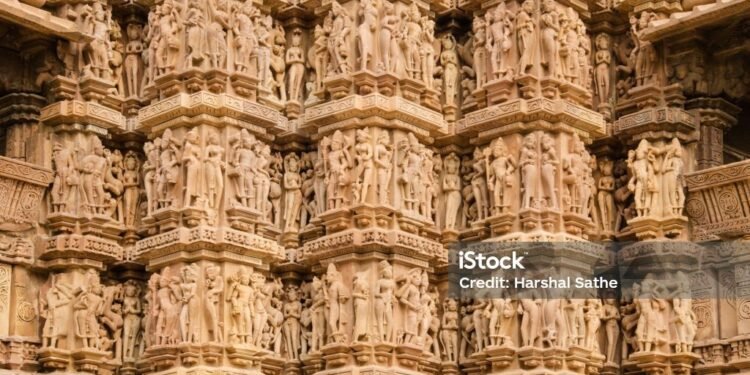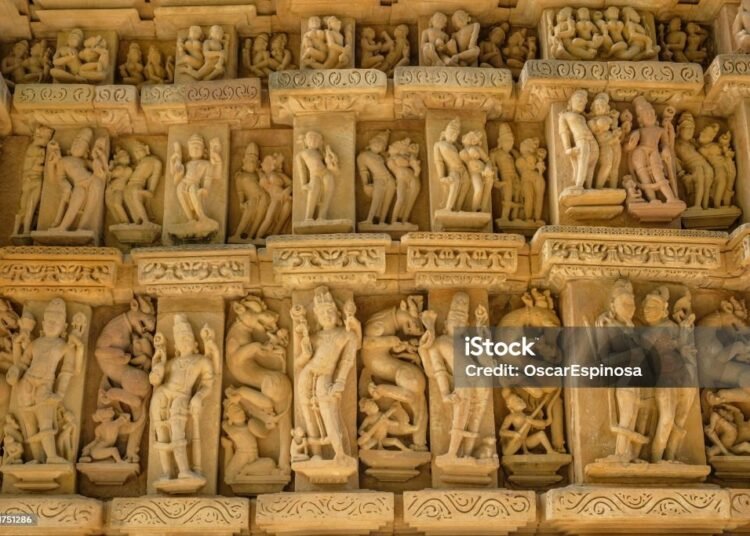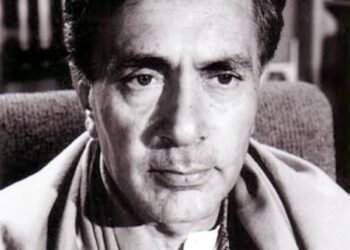Introduction
The Khajuraho Group of Monuments in Madhya Pradesh embodies a rare synthesis of sensuality and spirituality within the Nagara school of North Indian temple architecture. Built largely by the Chandela dynasty between the 10th and 12th centuries CE, these temples integrate erotic imagery, quotidian life, divine iconography, and mathematical temple planning into a coherent spiritual program. Far from being merely erotic art, Khajuraho’s sculptural narratives serve a deeper metaphysical purpose: moving the seeker from sensory allure on the exterior to contemplative stillness in the sanctum, an architectural journey mirroring the union of Shakti (creative energy) and Shiva (pure consciousness) central to Tantric thought.

Historical Context and Patronage
The Chandela rulers commissioned dozens of temples across Khajuraho, of which 23 survive in three clusters—Western, Eastern, and Southern—spread across nearly 6 sq km.
The ensemble represents a culminating moment in the evolution of Nagara architecture in central India, showcasing refined structural planning, sculptural virtuosity, and symbolic programs encoded in stone.
Nagara Architecture at Khajuraho: Form and Grammar
Plan and sequence: Temples follow the vastu-purusha-mandala, typically using the 8×8 (Manduka) grid organizing sanctum (garbhagriha), vestibule (antarala), mandapa(s), and circumambulatory path in axial alignment.
Superstructure: Curvilinear shikhara rises above the sanctum, flanked by clusters of subsidiary spires (urushringa) that accentuate verticality; the composition symbolically evokes Mount Kailash/Meru.
Platform and elevation: Highly ornate jagati (platform) elevates the jangha (temple body), with sculptural bands wrapping the exterior walls in rhythmic, repeating patterns akin to a visual text.
Orientation: All but one temple face the rising sun; entry occurs from the east, maintaining cosmological alignment and ritual directionality.
Spatial hierarchy: From ardhamandapa to mandapa to garbhagriha, space contracts and quiets, guiding the devotee from the profane to the sacred.
Sensuality Meets Spirituality: The Symbolic Program
Khajuraho’s most famous sculptural program harmonizes erotic scenes with deities, dancers, musicians, celestial nymphs, and everyday life, creating an encyclopedic narrative of existence. The placement is pedagogical:
Outer walls: Abundant maithuna (couple) imagery, playful surasundaris, and scenes of desire and worldliness dramatize kama and the energies of life.
Transitional thresholds: At doorways and sandhis (junctures), the tone shifts—guardians, auspicious motifs, and didactic panels mark the turn from outer engagement to inner awareness.
Inner sanctum: The garbhagriha typically abstains from figurative distraction, prioritizing the presence of the deity in stillness—an inward culmination of the journey.
Read this sequence as a Tantric allegory: the erotic is not profane but a kinetic expression of Shakti; when yoked to consciousness (Shiva), it becomes a pathway from multiplicity to unity. Sculptures become visual mantras—signs that point beyond themselves.
Iconography and Everyday Life
Beyond erotic panels, Khajuraho abounds in depictions of musicians, potters, farmers, dancers, and richly adorned women in daily acts—applying kohl, looking into mirrors, drying hair—celebrating beauty and human emotion with refined grace.
Feminine imagery is central: apsaras and nayikas are rendered with supple torsos, lotus-petal eyes, and intricate ornaments, embodying ideals of elegance and fecundity while also signaling the omnipresence of Shakti in the aesthetic field.
Signature Temples and Highlights
Kandariya Mahadev (Western Group): A pinnacle of Nagara composition with a soaring clustered shikhara and dense sculptural program—often cited as the stylistic high point of Khajuraho.
Lakshmana Temple (Western Group): Exemplifies panchayatana planning (main shrine with four corner shrines) and provides a textbook reading of Khajuraho’s narrative friezes.
Parsvanatha and Adinatha (Eastern Group): Testify to the plural religious milieu, with Jain iconography integrated into the same architectural grammar.
Design Intelligence: Mathematics, Myth, and Movement
Mandala logic: The 8×8 grid (Manduka) organizes space and meaning; Brahma padas at the core anchor the deity, while outer rings scaffold ritual movement and narrative expression.
Fractal repetition: Sculptural panels repeat with variation, like phrases in a stanza, building layered meanings; inscriptions often include poetry and puns, revealing a literate sculptural culture.
Processional pathways: Circumambulation aligns with the narrative sequence—from sensuous abundance outside to contemplative quietude within—making devotion a kinetic reading of stone scripture.
Interpreting the Erotic
The erotic corpus at Khajuraho is a minority of the total sculptural content but strategically placed to symbolize energy (iccha shakti) and the fullness of worldly life.
Some panels depict diverse sexual motifs within larger group scenes; their inclusion reflects a worldview that integrates, rather than moralizes, human experience into a sacred continuum.
Reducing Khajuraho to erotica misses its core philosophy: union, in body and spirit, is a doorway to the infinite.
Conservation and Experience
As a UNESCO World Heritage Site, Khajuraho is protected for its “Outstanding Universal Value,” representing the pinnacle of Chandela-era Nagara design.
Many temples are built in sandstone with delicate carvings; mindful tourism—respecting barriers, avoiding touch, and following conservation guidance—helps preserve fine details.
Best practice for study: approach east-to-west; read friezes in sequence; compare outer to inner iconography; note shikhara clustering and urushringas; observe platform moldings and banding; and pause in the sanctum to register the designed shift from multiplicity to stillness.
Conclusion
Khajuraho is a sophisticated discourse in stone where the grammar of Nagara architecture, the poetics of sculpture, and the metaphysics of Tantra converge. Its outward sensuality and inward serenity are not contradictions but complements—expressions of Shakti and Shiva seeking balance. To walk its platforms and pass beneath its clustered spires is to experience a carefully choreographed ascent from desire to detachment, from form to formlessness, from the seen to the seer.





